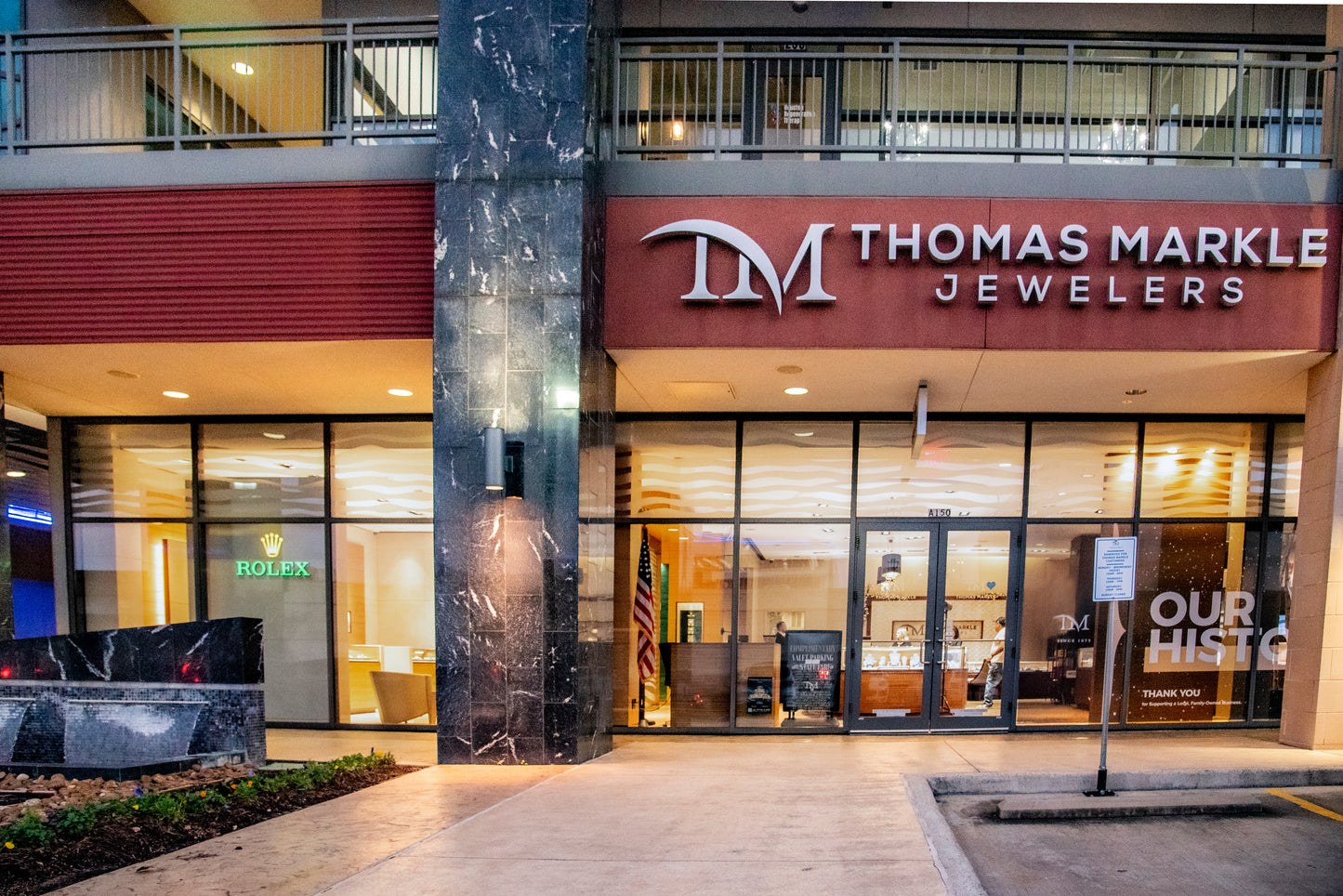This store requires javascript to be enabled for some features to work correctly.
Radiance is Our Nature...
Lab grown diamonds are the pinnacle of modern luxury. At Thomas Markle Jewelers, we offer a stunning selection of loose lab grown diamonds for your consideration. Each radiant gemstone is chosen for its exceptional quality, allowing you to find the perfect diamond to suit your discerning taste.
While shopping our selection online is a wonderful and convenient option, we encourage you to visit in-store for the superb bridal shopping experience you’ve been dreaming of.
Use the filters below to refine your search by indicating your preferred carat weight, clarity, cut, color and more.
A diamond's carat is its weight in milligrams, or one-fifth of a gram. The word "carat" comes from the Greek word kerátion, which means "carob seed". In the Middle East, ancient traders would use carob seeds to balance scales when weighing precious stones and metals, and the seeds' uniform weight made them an early standardized unit of measurement. The United States adopted the modern diamond carat system in 1913, and other countries followed suit.
Diamond clarity refers to the absence of blemishes and inclusions in a diamond, and is one of the four factors that determine a diamond's quality and value. The other three factors are color, cut, and carat weight.
Clarity is graded by the visibility of blemishes and inclusions under 10-power magnification. The closer a diamond is to flawless, the higher its clarity grade, the rarer it is, and the more it costs. Here are some clarity grades:
- Flawless (FL): No blemishes or inclusions visible under 10x magnification
- Internally Flawless (IF): No inclusions visible under 10x magnification, but may have minor surface blemishes that are not visible to the naked eye
- Very, Very Slightly Included (VVS): Inclusions are so slight that they are difficult for a skilled grader to see under 10x magnification
When determining a clarity grade, graders consider the number, location, and relief of any inclusions. The greater the number of inclusions, the lower the clarity grade. Inclusions closer to the center of the table tend to have a greater impact.
Diamonds are graded for an absence of color, rather than the presence of color. The white diamond color scale is divided into 23 shades:
- D-E-F: Colorless
- G-H-I-J: Near colorless
- K to Z: Slight traces of color
D-E-F diamonds are usually set in platinum or white gold to avoid color reflection from yellow or rose gold. However, because they are colorless, they can be set in any meta
When describing a diamond, the terms "cut", "polish", and "symmetry" refer to the diamond's overall appearance and how it interacts with light:
- Cut: The diamond's angles, proportions, and finishing, which affect its brilliance and fire.
- Polish: The diamond's surface finish, which is rated on a scale of Good (GD), Very Good (VG), Excellent (EX), and Ideal (ID). A well-polished diamond will have a smooth surface without visible scratches or abrasions.
- Symmetry: The balance and proportion of the diamond's facets, and how they align with each other. Symmetry is graded on a scale of Poor, Fair, Good, Very Good, and Excellent.
A diamond's symmetry is important because it defines how the diamond reflects light. An asymmetrical diamond won't reflect light as well as a diamond with an Excellent symmetry grade.
The distance from the bottom tip, called the culet, to the flat top surface, called the table. It is usually expressed as a percentage or in millimeters in grading reports. To calculate the depth percentage, divide the total depth by the average diameter and multiply by 100.
The strength of a fancy diamond's color, which is determined by three factors: the diamond's main color, tone, and saturation. The Gemological Institute of America (GIA) developed a scale with nine intensity levels to categorize fancy color diamonds:
- Faint
- Very light
- Light
- Fancy light
- Fancy
- Fancy intense
- Fancy vivid
- Fancy deep
- Fancy dark:
In general, a diamond's value increases with its color intensity. However, there is a point where a diamond's value begins to decrease if it becomes too saturated. For example, a diamond with a Fancy Dark or Fancy Deep color may have a value that declines due to its high saturation. Fancy color diamonds are rare and desirable because of their beauty and scarcity. They can come in 12 pure hues, including yellow, blue, pink, orange, green, brown, gray, purple, violet, red, and white.
Diamond fluorescence is the glow that a diamond emits when exposed to ultraviolet (UV) light, usually appearing as a blue color. It's caused by the absorption of energy from UV light by electrons in natural elements like boron, nitrogen, or aluminum that were present when the diamond formed. Here are some things to know about diamond fluorescence:
- Grading: The Gemological Institute of America (GIA) grades diamond fluorescence on a scale of "none" to "very strong" based on the intensity of the glow.
- Appearance: While diamonds with strong fluorescence may appear milky or lifeless in daylight, a 1997 GIA study found that in most cases, fluorescence doesn't affect the diamond's appearance.
- Cost: Diamonds with strong blue fluorescence can be 20–30% cheaper than non-fluorescent diamonds of the same color grade.
- Rarity: Diamonds with no or faint fluorescence are rarer than those with strong or very strong fluorescence.
GIA: GIA, the Gemological Institute of America, is the leading gemological laboratory in the world. It is the industry’s most trusted and most widely used service. Headquartered in Carlsbad, California, GIA has offices in many cities around the world, employing more than 1400 scientists, educators and certified diamond graders.
Besides gem grading and certification, GIA also provides educational services and carries out intensive research work to keep up with fast changing technologies in the gemological field.
In the industry, the GIA diamond reports are highly recognized for their strict grading standards and proven consistency. When buying an engagement ring with a GIA report, it provides you with the greatest peace of mind that the diamond’s quality is accurately represented.
AGS: AGS stands for American Gemological Society and it is also a US based laboratory (with main offices in Las Vegas). The AGS laboratory is renowned for its scientific approach and research in diamond cut grading. Instead of using an alphabetical rating system, AGS uses a scale of 0-10 for rating a diamond’s characteristics, with 0 as the best and 10 as the worst.
Like GIA, AGS is also known for their ethical standards and consistency in their grading system. In the US market, the AGS lab is the second most widely used lab service after GIA. They are also globally consolidated through offices in Israel, Belgium, India, China and Hong Kong.
EGL USA: EGL is an abbreviation for European Gemological Laboratory. It is a European founded grading agency and has a big global presence – with offices in London, Paris, Tel Aviv, Tokyo, Johannesburg, among others. EGL is known for pioneering diamond grading techniques for stones weighing less than a carat and has a large market share in Europe.
They are also notoriously known for the introduction of the ‘SI3’ clarity rating for diamonds and have also been embroiled in controversial consumers lawsuits for over-grading diamonds.
In addition to carat, a diamond's size is also measured in millimeters by length and width, and is defined by its dimensions, such as length, width, and depth. A diamond's diameter can also indicate its apparent size, especially when comparing similar diamonds. The size and carat of a diamond can vary depending on its shape, with fancy shapes tending to be heavier and smaller than round diamonds.
A diamond's ratio is the proportion of its length to its width, measured at its widest point. It's a crucial factor in a diamond's appearance, and can affect its brilliance and how balanced the ring looks.
To calculate a diamond's ratio, divide its length by its width. For example, if a diamond is 6 mm long and 4 mm wide, its ratio is 1.5.
Here are some things to know about diamond ratios:
- Appearance: A diamond's ratio affects its appearance, with higher ratios making it look longer and thinner, and lower ratios making it look more round.
- Personal preference: Some people prefer a more elongated shape, while others prefer a more square or equal shape.
- Brilliance: Experienced diamond cutters know how to cut proportions to maximize a diamond's shine. A poorly-cut diamond may look dull or lifeless.
- Cut: Different diamond cuts have different ideal length to width ratios:
- Marquise: A classic ratio of 1.75–2.15
- Pear: A ratio of 1.5 is considered a perfect balance, while 1.6 and over gives an extra-elongated look
Table is the flat, square-shaped facet on the top of a diamond that's visible when the stone is face up. It's the largest facet on a
diamond and plays a key role in how the diamond looks and performs in light.





